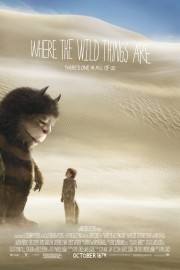Where the Wild Things Are
I’ve read a lot about Spike Jonze’s adaptation of “Where the Wild Things Are” over the years. As a fan of his brilliant films with Charlie Kaufman- “Being John Malkovich” and “Adaptation.”- and with some vauge memories of Maurice Sendak’s beloved children’s book, the match was seemingly made in heaven.
The four year wait for the collaboration is, by and large, well worth the wait. The one big change to the book- how Max gets to the land of the wild things- is a glaring one as the film unfolds, but Jonze and co-writer Dave Eggers (who also made an impression onscreen with this summer’s “Away We Go”) have otherwise stayed true to the heart of Sendak’s story.
Max is a young boy with a troubled life. His father is absent, his friends aren’t many, and his mother (the wonderful Catherine Keener) is otherwise pre-occupied, whether it’s work or her boyfriend (Mark Ruffalo). As a result, Max acts out, sometimes in a wolf costume that might remind some of the bunny pajamas of “A Christmas Story” (only grungier).
One night, after a particularly upsetting incident with his mother, Max runs away. He makes his way to the water, where he finds a small boat, and sails off. He eventually reaches an island, populated by a family of weird-looking creatures, themselves a family of sorts. After the initial fear subsides, Max sets himself up as their king. But things aren’t as rosy as anyone would think.
My friend Ron- after we saw the movie in IMAX last night- brought up an interesting point. He didn’t like the film as much as he wanted to, as he likened it to a movie that tried to be a film like “The Neverending Story” but didn’t quite gel. I’ve been thinking about that ever since, and one of the strongest elements in the film for me is how Jonze- who enlisted Jim Henson’s Creature Shop to create the Wild Things- is harking back to the family films of my childhood in sensibility and design. Stuff like “Neverending Story,” “The Dark Crystal,” “Labyrinth,” and even “E.T.,” which had a powerful impact on me growing up (they’ve lost none of their strength since).
A lot of that came from their tactile look. Nowadays, CG would be used extensively to make such films, but back then, the use of practical effects and puppets made the films feel more real. And while the opticals in something like “Neverending Story” have dated, the overall impact hasn’t.
Now let’s consider “Where the Wild Things Are.” Jonze’s sensibilities have always been on the wild side, shall we say. (Check out his music videos for groups like The Beastie Boys if you don’t believe me.) But one look at his films with Kaufman, and you see why he was perfect to direct “WTWTA.” Like those films, Sendak’s story is ultimately about the nature of self-discovery and personal identity. We also see moments where Max (played by Max Records in a wonderful performance that is perfect for the character- unruly, selfish, yet ultimately understanding) must also learn about responsibility for one’s actions and, well, growing up. By taking on a parental role of sorts with the Wild Things, Max realizes that he’s not well-suited for such responsibilities yet, especially when he makes decisions that hurt Carol (voiced by the great James Gandolfini), Judith (Catherine O’Hara), and Alexander (Paul Dano). That’s ultimately why he must return home by the end- his time with the Wild Things, all of whom reflect aspects of himself, shows him the error of his ways at home, and how he needs to make things right.
This is also reflected in the music. Along with underscore by Carter Burwell (now on his third film with Jonze, although shortchanged considerably on the soundtrack album), we get a set of beautiful, haunting, and jubilant songs by Karen O and the Kids. You won’t hear better songs this year, not just in quality but in how they serve the film. “All is Love” is the big “theme” of the film (at least that’s what the promo guys want you to believe), but the lovely “Worried Shoes” says more about what the film is. It’s elegant minor melodies are repeated frequently at key moments in the film, and define the film’s emotional journey.
So much to talk about with this film. I haven’t even mentioned the superlative voice work by Chris Cooper (as Carol’s best friend Douglas), Lauren Ambrose (as the conflicted KW), and Forest Whitaker (as the hole-punching Ira), who match Gandolfini, O’Hara, and Dano emotion for emotion in this dysfunctional family. The look of the film (shot in Australia), with Lance Acord’s hand-held camera adding to the film’s tactile reality. The hand-crafted art direction that makes the land of the Wild Things as real as the home life Max escapes early on. And then there’s the perfection of the ending, which says more about family, love, and friendship by saying less. Ultimately, isn’t that what Sendak did in the first place?










